Today we welcome new writer Jack Surtees to TFT. He has some interesting insights that should pique the interest of fellow cricket aficionados with a penchant for data. Peter Moores would absolutely love this…
Largest Run Contributions in Men’s Tests 2022
Cricket in 2022 was quite the ride. It featured two World Cup finals, an expansion of the IPL, rather a lot of international captaincy drama, the retirement of some legends and the passing of some others, a collection of incredible finishes in all formats and (my personal highlight) the complete reformation of the England Men’s Test team from dour draw snatchers to free wheeling gunslingers. Finding out how well that approach fares in the upcoming Ashes is a tantalising prospect. For now, however, it’s time to reflect on all that we witnessed in a year that started with a Conway ton and ended with a Williamson double.
In this article we will be delving into the great batting performances we saw in men’s test matches throughout the year. Specifically, looking at the largest run contributors from each test, reliving the drama and discussing who might have had the greatest impact, both individually and accumulatively. But to do so we first need to define two ideas. Primarily, what exactly is meant by ‘largest run contributor’ and, secondly, what we might expect a ‘typical’ contribution to be.
What does ‘largest run contributor’ mean?
To define the first idea we will take my favourite series of the year as an example. The New Zealand Men’s Test tour of England. For a little context, despite the 3-0 scoreline, this series was anything but a foregone conclusion. England were coming off possibly their lowest ebb since the 2013/14 Ashes, an excruciatingly drawn out 1-0 loss in the West Indies, and New Zealand had only 12 months previously been crowned the first World Test Champions.
The cricket itself was riveting. Bowling masterclasses and battling counterpunches characterised the first and last tests while Trent Bridge, sandwiched in the middle, provided us with possibly the Test of the year. A hard fought run fest that grew into an all-timer of an explosive finish. It was the moment the Bazball truly announced itself and that Bairstow cemented his legacy.
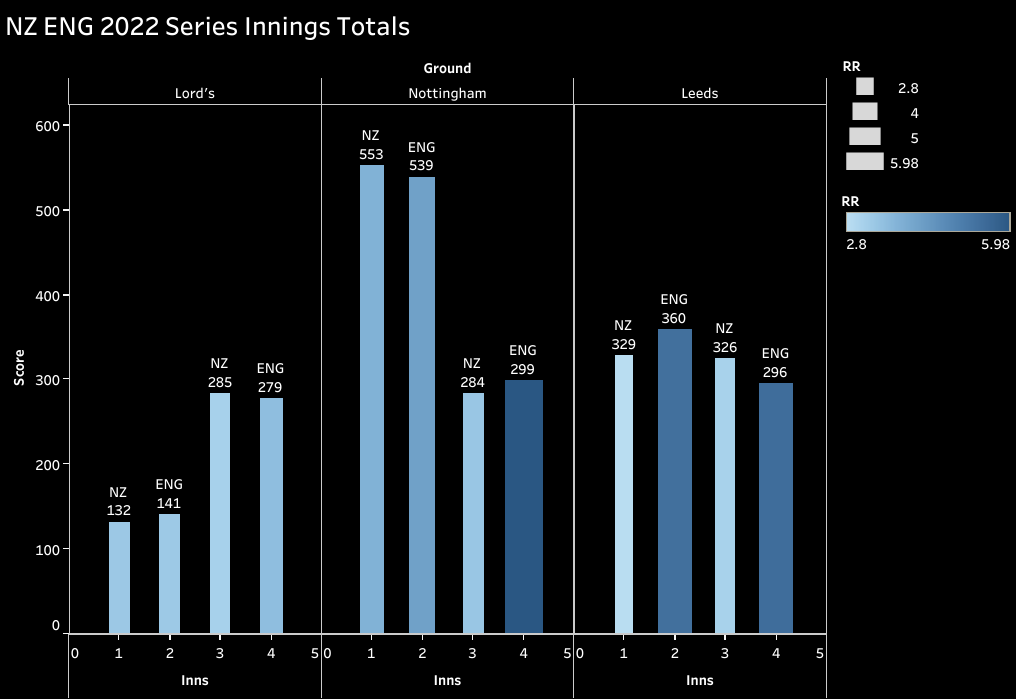
In total New Zealand scored 1,909 runs throughout the three tests, while England just pipped them by scoring 1,914. These totals might seem extremely close over the course of three tests but it makes more sense when you consider that each was won by the chasing team.
What we’re interested in, though, is where those runs came from. The graph below shows us a breakdown of run contributions throughout the series. We can clearly see that both teams had two major contributors: Mitchell, Blundell, Root and Bairstow. However, while England’s duo were ably supported by Pope, Stokes, Lees and a one off knock of 97 from Jamie Overton, New Zealand’s next highest contributor, Conway, was someway off.
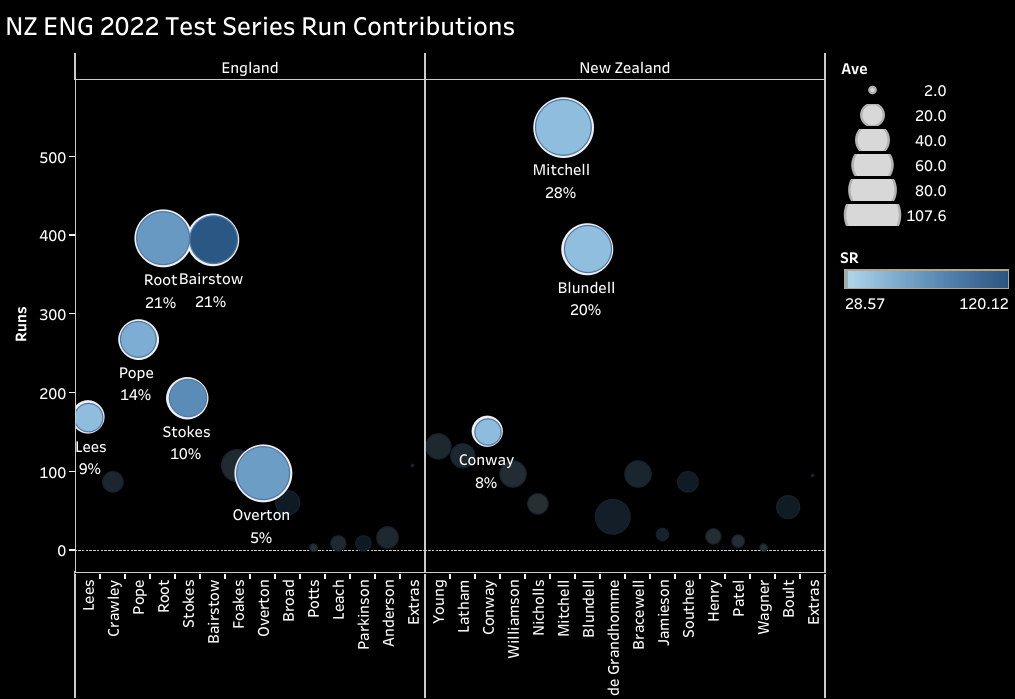
Of the major contributors, Blundell scored 20% of New Zealand’s total runs by himself, Root and Bairstow ever-so-slightly eclipsed him by both scoring 21% of England’s total runs (in Jonny’s case these came at a strike rate of 120!), but by far the greatest contributor in the series was Daryl Mitchell with an astounding 28% of New Zealand’s total, coming at an average of 108.
This is what we mean by ‘largest run contributor’. The player that scored the highest percentage of their teams total runs. To be clear, that means a player could score the most runs individually in a test but still not be the largest run contributor if their team significantly outscores the opposition.
As opposed to the demonstration above, however, we will not be looking at series totals. Instead we will be looking at each test individually. Effectively, we will be finding the players that had the greatest batting impact for their teams in each test, and judging whether singular moments of batting genius were a recipe for success in 2022.
What is a ‘typical’ contribution?
The other idea that we should first establish is what might be thought of as a ‘typical’ contribution for a batter in a test. Mainly for some context against which to judge the stalwarts of 2022.
This, however, is not an easy thing to do. You could say that there are 11 players in a team so you would expect each of them to score roughly 9% of the total but that’s just not how cricket works. Each team is composed of a certain number of bowlers, who generally take the majority of the wickets, and a certain number of batters, who generally score the majority of the runs. You would, therefore, clearly expect a higher percentage of runs to come from the batters.
Unfortunately, there are so many variables at play – the era, the batters position, the venue, the match situation, the composition of the XI etc. – that it is effectively impossible to find a definitive expected contribution for each batter.
So what I’ve decided to do is take an established test XI, a team that played together for a number of years, and then use each player’s respective career averages to figure out a rough guide for the percentage of runs you might reasonably expect each batter to contribute.
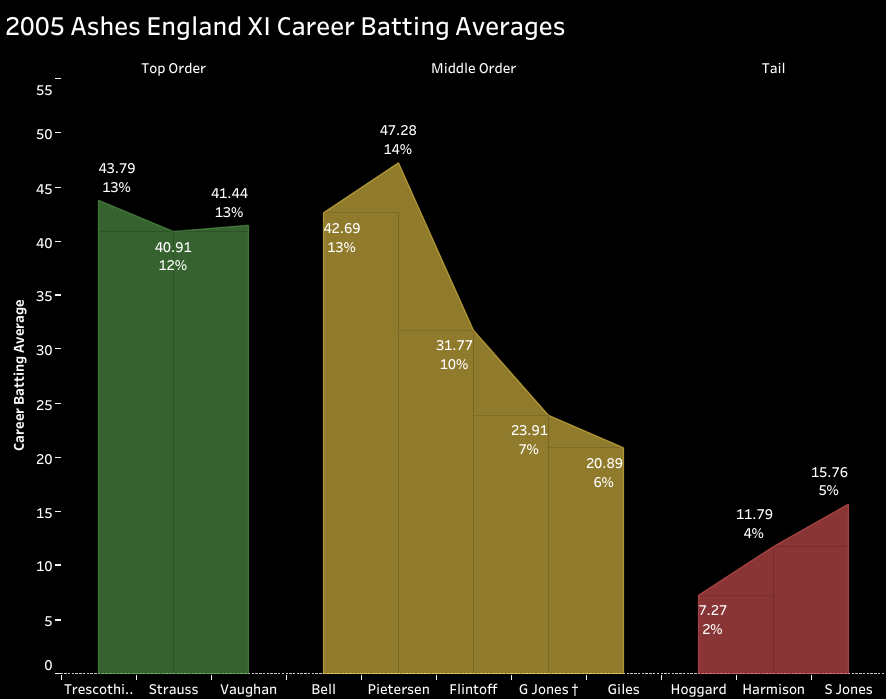
The team I’ve chosen to use as our benchmark is the 2005 Ashes England Men’s XI (the XI from the first four tests anyway) and there are a number of reasons why: they have a fairly traditional composition – three out-and-out seamers, one spinner, one (dyanmite) all-rounder and six batters; they’re all now retired so the data won’t be skewed by any ongoing purple patches; and, though they were a very good side, they’re not one of the greatest of all time so we’re unlikely to be skewed by any anomalous careers. They also happen to be the reason I love cricket.
Anyway, what the averages show is that we can expect the top order, batters one to three, to contribute roughly 40% of a teams total with each player providing around 13% of that total. The middle order, batters four to eight (I know I’m being generous with Giles here), should contribute around 50% at around 10% each, and with the tail you would only expect 10% of the total at around 3% each.
Obviously no one innings will ever reflect these contributions exactly but over the course of a few series’ or a few seasons you might expect to see these sorts of contributions. Which highlights just how dominant Mitchell was in the prior mentioned series. His output over three tests was the equivalent of what you might typically expect from three middle order batters, combined.
The final thing to mention before we delve into the data is that the reason for choosing test matches (other than the fact that it’s by far the greatest format) is that it’s simply more difficult to have such a heavy influence on the contest. Two innings means that, whilst you might top score in the first, if you don’t perform in the second you’re unlikely to feature on this list. Unless, that is, that first contribution was truly extraordinary in and of itself. Basically we’re looking for the best of the best here, and with that said, let’s see what 2022’s batters had in store for us.
2022’s Largest Run Contributors
There were 43 test matches over the course of 2022. That means 43 places up for grabs in our data set, which were shared between 35 players. The most frequent presence in that list comes from Pakistan’s captain and talisman Babar Azam who, astoundingly, played nine tests in 2022 and finished as the leading contributor in 4 of them. Though, whether that singular impact is down to Babar’s brilliance or a lack of reliable teammates is up for debate.
What can’t be debated, however, is that this year has easily been the best we’ve seen so far in a career that seems to be headed for all time great status. His effervescent drives and nonchalant flicks saw him make a world leading 1184 runs at an average of 70 throughout his nine matches in 2022, and included probably the defining innings of his career to this point: batting for over ten hours to score 196 off 425 in the fourth innings against an Australian attack featuring Cummins, Lyon and Starc. It was an innings that, for a brief, glorious moment, gave us hope of an unprecedented Pakistan victory after having conceded a first innings deficit of 408. His dismissal in the 160th over all but ended those flickering hopes but his efforts weren’t in vain, securing a draw from a position of almost certain defeat.
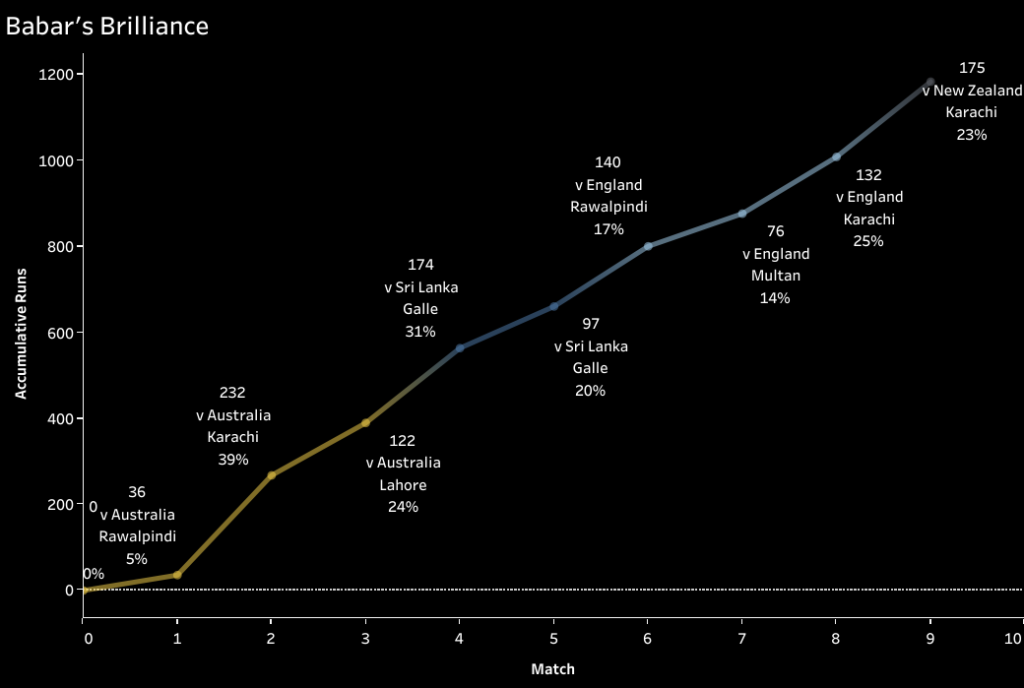
Above is a cumulative chart of his runs across the 9 matches Pakistan played in 2022. He finished as the largest contributor in the aforementioned match against Australia in Karachi (39%), both of the Sri Lanka tests in Galle (31% and 20%) and the final test of the England series again in Karachi (25%).
That was not the extent of the contributive burden that he shouldered, though. In fact, the only match in which we can say that he didn’t outperform his expected contribution was his first appearance of the year against Australia in Rawalpindi. Across the full year he contributed 22% of Pakistan’s total runs. Put into context that’s a 12 month period in which he fulfilled the expected contribution of two middle order batters by himself, all while captaining. That’s some effort.
Next on the list comes Travis Head with three appearances, then Bairstow, Usman Khawaja, Ollie Pope each with two, and, once again, 2022 can undoubtedly be said to have been the best year of their respective test careers so far.
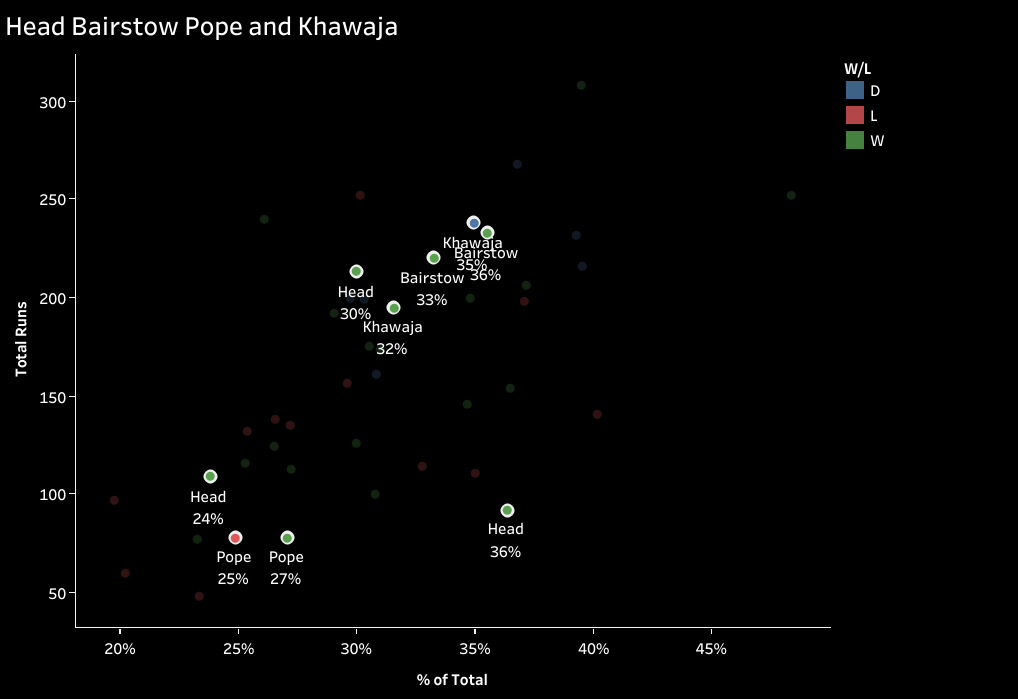
Pope and Khawaja finally secured their places in their respective top orders after both had been dropped in recent years and each played a major role in historic series wins both home and away.
Pope’s two appearances in the data came during the low-scoring home series against South Africa when he topped both the averages and the run scoring list. England, however, only won one of those matches and lost the other.
Khawaja’s appearances, meanwhile, came in two much higher scoring matches, with him contributing significantly more in terms of both % and runs across both innings. The first came in the drawn Ashes test at Sydney when he scored twin hundreds during his first return to the test XI since 2019. The second, however, was the key contribution in the final test of the Pakistan tour, a 91 in the first innings and a 104* in the second that allowed Australia to seal the series 1-0.
Head and Bairstow made their contributions from the middle order and both, actually, had very similar years in test cricket. Prior to 2022 each had displayed patchy form at best and they’d both been subject to questions over whether they warranted their place in their respective teams. But over the previous 12 months both players have firmly dispelled any such debate through consistent dominant displays, achieved in both cases by bringing their more aggressive white ball mindsets to the test arena.
Head started the year by being named player of the series in his first home Ashes and went on to provide match winning knocks against England, the West Indies and South Africa, and managed to score fluently on both batting friendly surfaces and minefields. Overall he averaged 50 at a strike rate of 81.
Bairstow, meanwhile, averaged slightly more (66) while striking at slightly less (76). Both of his appearances in the data came in high scoring affairs, adjacent test matches actually, during a run in which he scored four centuries and 71* in five consecutive innings. Maybe the greatest stretch of innings in English test history. Both of their contributions went beyond numbers, however, as each became their side’s go-to match winner over the course of 2022. In fact, in every match that either of them finished as the largest run contributor, their team won.
Which brings us to another point of reflection. Does having the largest run contributor result in winning test match cricket or is it more a symptom of an under performing batting unit?
My initial thoughts were that the answer would probably be closer to the second idea. I generally associate extreme run contributions with one player excelling while their team flails around them (probably on account of me being an England fan during the Root era) and was therefore of the belief that a more well distributed collection of contributors would triumph more times than not.
But the data proved me wrong here. Of the 43 total matches, the team with the largest contributor won 23, drew 7 and lost 13. That’s a healthy 53% win percentage, enough for third place in the world test championship table at the turn of the year. Of course context is important here:
- In low scoring matches (where the combined run total of all four innings is less than 900) teams that had the largest run contributor won 69% of the time. In these situations it seems that having the outstanding performer has the greatest impact in terms of winning. It’s not a guarantee, though, since these sides also lost 31% of their matches.
- In middling match totals (between 900 and 1,200 runs) the results were more evenly spread. Winning occurred 53% of the time, draws made up 16% of the data and losses 31%.
- And that trend continued in high scoring matches. Where the combined run total was over 1,200 teams with the largest run contributor won 36%, drew 36% and lost 27%.
We can definitively say, therefore, that in 2022 having the largest run contributor in a low scoring test match gave that team a much greater chance of winning, whereas in a high scoring match it didn’t necessarily improve their chances of winning but it certainly made them less likely to lose.
Soon we will be looking at the five largest run contributions that we saw in test matches throughout the year but before we do that we’re briefly going to cast a glance at some of the more surprising names that appeared on our list:
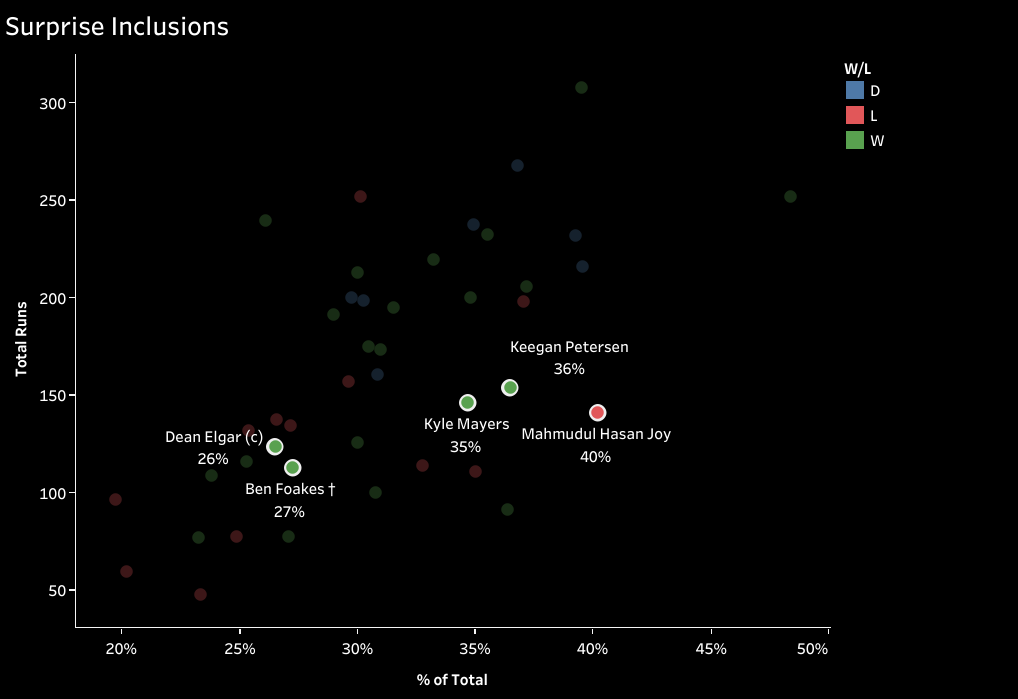
- Dean Elgar endured his worst test returns since 2019, averaging only 29, but that still included a match-winning second innings 96* against India in January. A match in which he provided 26% of South Africa’s runs.
- Similarly Keegan Petersen ended the year having lost his place in an extremely flimsy South African batting lineup but he, too, strung together a match-winning performance against India in January, providing 36% of his team’s runs in another low-scoring affair.
- Mahmudul Hasan Joy also found himself on the outside looking in by the end of the year, and this came after a test best 137 helped him to provide a whopping 40% of Bangladesh’s total during a shambolic 220 run defeat to South Africa in March.
- Kyle Mayers may only average 36 in the Windies middle order but he seems to specialise in match winning contributions, his 146 (36% of the West Indie’s total) in June enough to see off Bangladesh by a resounding 10 wickets.
- And, finally, a player who never quite seems assured of his place despite having a decent overall record and a claim to be the best current gloveman in cricket. The 113* Ben Foakes made against South Africa in August ended up being 27% of England’s total and helped them to an innings victory to level the series.
And, so, finally we come to the largest run contributions in 2022. These five performances had the single greatest batting impact in test matches this year. Interestingly, only two of them resulted in wins. Two were epic, all-time stands to play out for draws and the last was a one man show, fighting to keep their team in a test where none of their teammates reached fifty:
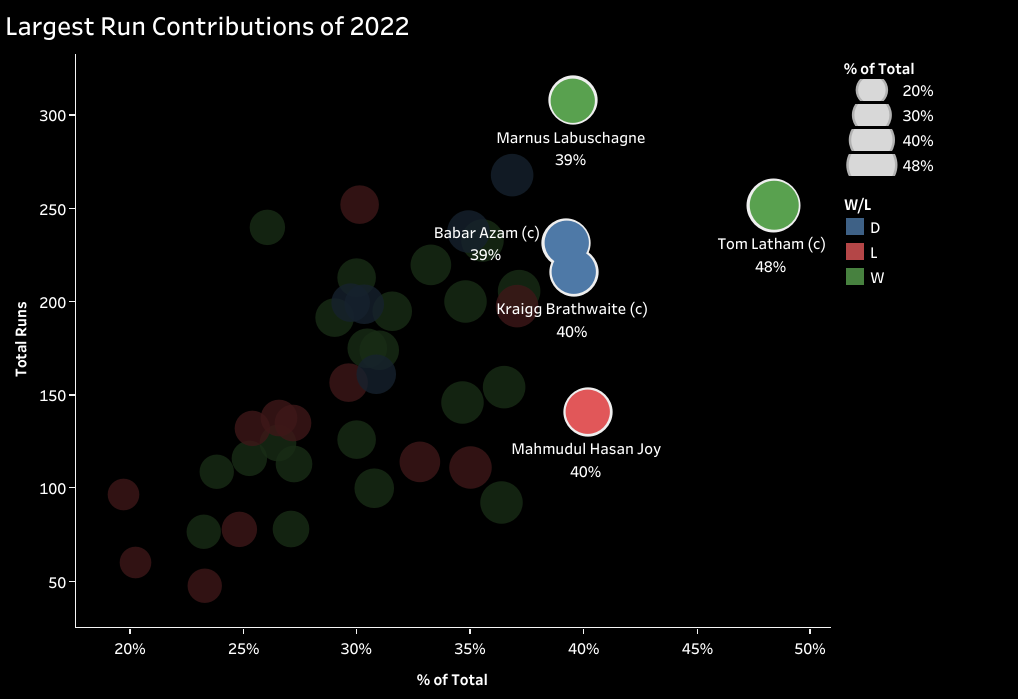
5. Babar Azam vs Australia in Karachi – 232 Runs – 39.26%
We’ve touched on this one already but it’s worth looking briefly again. This was a truly special effort that will be recalled often in years to come. It was the first really definitive test innings from a budding legend and, honestly, this list would have felt incomplete if Babar didn’t make the top five. For, in terms of batting performances, 2022 belonged to him.
4. Marnus Labuschagne vs West Indies in Perth – 308 Runs – 39.49%
Next up we find a performance from the back end of the year. The match itself wasn’t much of a contest, with Australia only losing six wickets across the five days, but that shouldn’t take away from what was an outstanding effort by Labuschagne. In this match he became only the eigth player to score a double hundred and a hundred in the same test match and he managed to catapult himself to the top of the ICC test match rankings in the process. All whilst sledging himself. Not a bad weeks work.
3. Kraigg Brathwaite vs England in Bridgetown – 216 Runs – 39.56%
Just edging out Marnus to the third spot is the captain of the West Indies team that Labuschagne torched. Kraigg Brathwaite has been around for a while now, being more or less the only consistent presence in the Windies test XI over the last decade or so. In fact, as of January 2023, he has made the last 11 hundreds by West Indies openers (a run stretching back to 2011!). In March he set another record, facing 673 balls across the Bridgetown test, a record for a West Indies cricketer and a performance of staggering concentration that helped to draw the test and win the series.
2. Mahmudul Hasan Joy vs South Africa in Durban – 141 Runs – 40.17%
In the number two spot we find the only player that was defeated in the top five. Mahmudul Hasan Joy who, as previously mentioned, found himself out of the XI only a few months on from this display, was the one spark of positivity in an otherwise drab Bangladesh showing back in spring. He currently averages only 26 in test match cricket but given his countries results over the course of 2022 you wouldn’t bet againts him getting another run in the side before too long.
1. Tom Latham vs Bangladesh in Christchurch – 252 Runs – 48.37%
The largest run contribution of 2022 goes to a man who, overall, has had a pretty good time of it over the previous 12 months, particularly in ODI’s where he finished the year averaging 56. It’s really saying something when you consider that his 252 run contribution against Bangladesh probably wasn’t his performance of the year but it’s worth reflecting on an innings that made up a staggering 48% of New Zealand’s total runs. That’s the expected contribution of more or less the entire middle order and it came at a strike rate of 68. He only played one innings in the match (which definitely aids his case in this dataset) but earned the highest test score of the year in the process and led New Zealand to victory by an innings and 117 runs. A fitting reward for such an exceptional performance.
Honourable Mention
There is one other cricketer featured in our dataset that somehow hasn’t had a mention yet, but I feel would be remiss to ignore. Dinesh Chandimal had a simply sensational year. After a few lean years he stormed back into the cricketing consciousness in 2022 averaging 103 across six test matches in which he scored two hundreds and four fifties. The highlight being the performance that put his name in our list. 206 runs, or 37% of his teams total, to give Sri Lanka an astonishing victory against Australia. By an innings and 39 runs no less. It was a performance good enough for sixth on our list but one that couldn’t be ignored when it came to discussing the greatest contributions of 2022.
Jack Surtees
You can follow Jack’s blog 176 Analystics here.

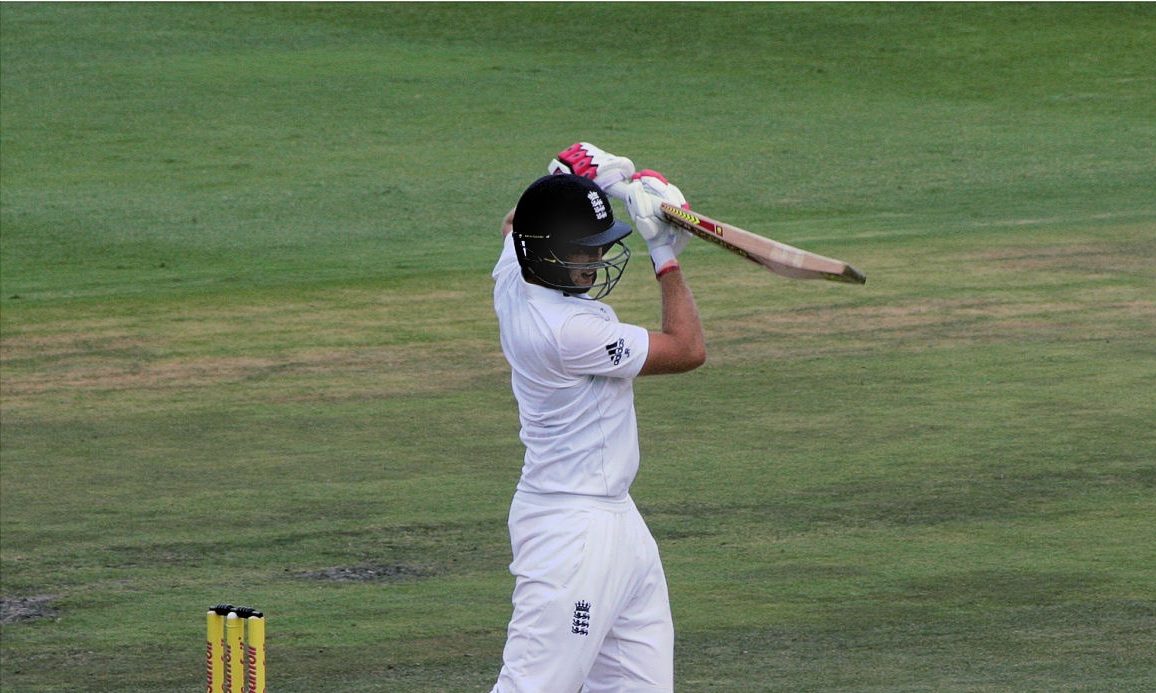



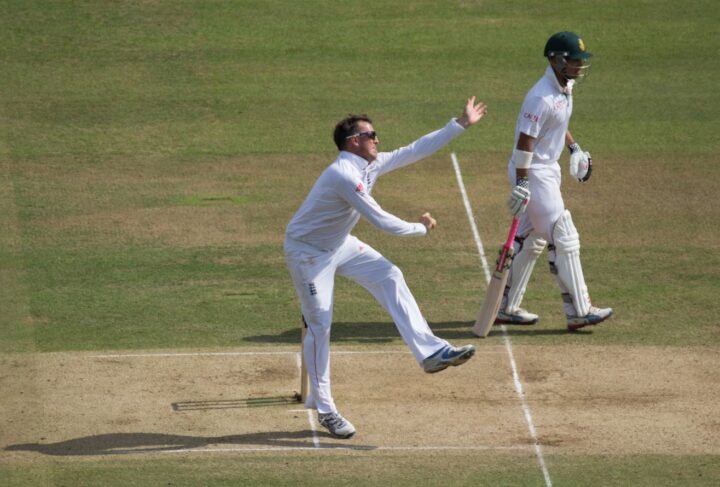



I hope somebody’s told Smith and Labuschagne they have to score at 10 an over in the forthcoming Ashes or we’ll all get bored and start watching Tik-Tok instead.
I admire people like Jack here because cricket stats really are a labour of love aren’t they. I don’t mind a few here and there but they don’t really do much for me and I’ve always thought you can really only compare each era of the game. I mean Hobbs was still making 100s at age 47 whereas these days careers are generally much shorter. Bowlers on uncovered Edwardian wickets had averages under 20. These days half the time they are flogging themselves to death on roads, represent Tests in Pakistan and Australia for example. Mind you England’s do or die approach to red ball should bump them up a bit!
my fav tom Latham! He is left-handed.
Jack,
A very interesting article backed up by insightful analytics. This does get the mind thinking and retrospectively review different decades and teams. Very enjoyable.